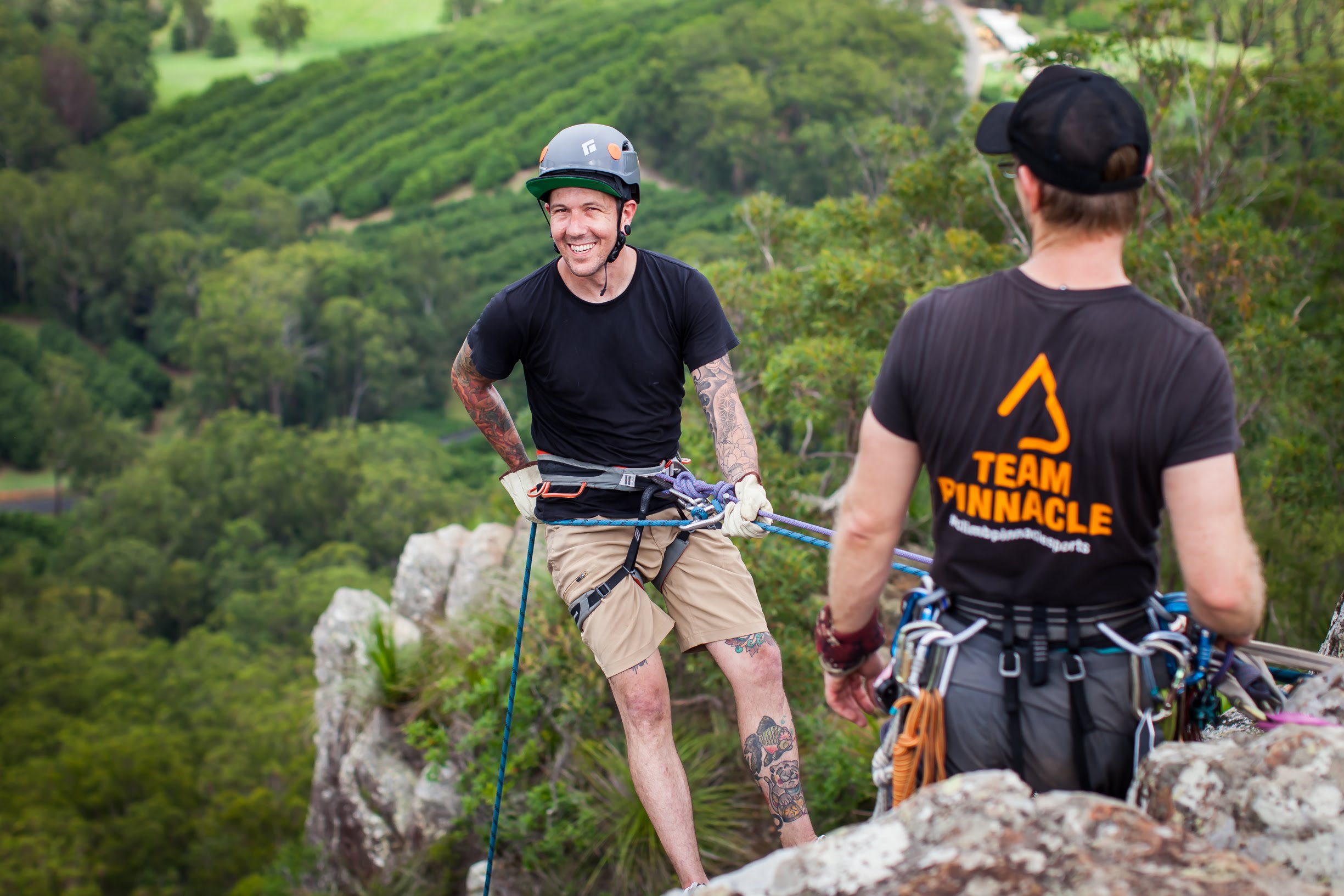“Scary rappels, huh? I’ve got the perfect product for you, if you’re into that sort of thing.”
That was how I ended up with the Beal Escaper in my hot little hands. I wasn’t sure that I would ever use it in anger, but I was undeniably intrigued. For those who perhaps aren’t familiar with this new-fandangled piece of rope wizardry, the Escaper is a device which allows the brave to effect a retrievable, single-rope rappel.
How does it work? Well, that is a fine question. The answer, like many things in climbing, is friction. Without going too far into it, a friction hitch that appears to be the lovechild of a DNA Double Helix and a Chinese Finger Trap secures the device under load, but also allows it to detach from the anchor once unweighted.
To get a better idea of how this works, you’ll need to consult the instructions. These are printed on the product packaging and look like the Necronomicon would if it were written by Ikea. The series of 6 images is entirely bereft of words, a fact which surely alludes to the terrifying portents contained within. Had the instructions contained text, I can only assume they would have read something like this:
Steps 1 – 3: Rethink your life.
Step 4: As you weight the system, ensure your face is entirely devoid of expression. Failure to do so will cause the system to explode.
Step 5: Eight shall be the number of the pulling, and the number of the pulling shall be eight. Nine shall thou not pull, neither pull thou seven.
Step 6: Thank your chosen deity.
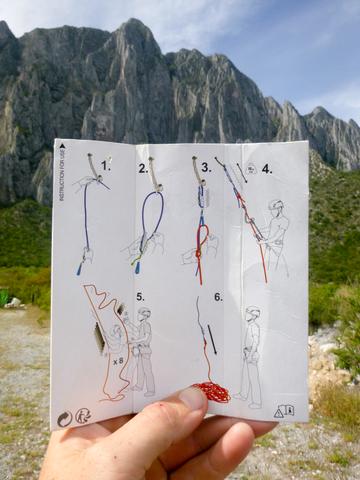
Ok, so I’m not being entirely fair to Beal here. Inside the package can be found a neatly-folded leaflet with detailed instructions written in many languages. As well as providing technical specifications, these encourage the user to become familiar with the product in a controlled setting. I didn’t need to be told twice.
I understand the theory behind the Escaper, just as surely as I trust the UIAA rating that tells me it is good for 18Kn of force. This is entirely academic and does little to remove my sense of dread, just as the enormous statistical improbability of getting munched by a shark in no way persuades me to swim in the ocean. I just don’t trust the Beal Escaper. Not like that. Not yet.
With no small amount of irony, I rigged the Escaper in the limbs of a tree as the proud and towering Sendero Luminoso formed a stunningly vertiginous backdrop. The modest height of 3 metres seemed like more than enough to begin with. After committing my body weight to the device, I gave the rope the prescribed eight firm tugs, counting as I pulled. Sure enough, the rope came free.
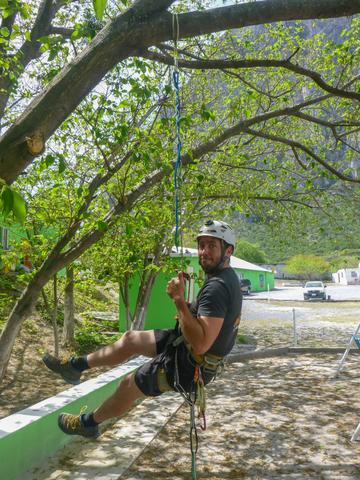
In for a penny, in for a pound, as they say. My next stop was Virgin Canyon, a popular crag within El Potrero Chico, where long pitches are common and rappelling shenanigans are a rite of passage. I found the perfect muse in Selam, a classic 5.10a which pushes the respectability of single-pitch cragging with a length of 40m. A slightly shorter length would have meant missing out on some sporty moves through a rooflet – to hell with that! The FA’s were having none of those negative vibes, the result being that you get to enjoy the pulling the roof shortly before terrifying yourself as you abseil off the end of your rope some 5 metres above the deck. A better candidate for a retrievable single rope abseil could scarcely be possible.
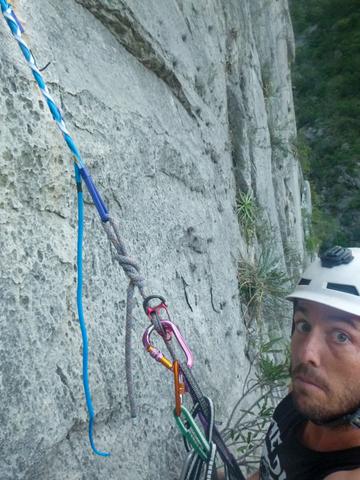
I climbed the route and allowed my seconder to descend via the safety of the bolted anchor. Then I set up the Escaper. First, I loaded it with my body weight and two back-ups. Then one back-up. Suddenly, it was crunch time, so I removed the last back up and took a selfie which will probably void my insurance policy. Committing my full body weight to the Beal Escaper was one of the more mentally committing things I’ve ever done in my climbing career, but in the end (spoiler alert), everything worked out fine… just as one would assume from a fully-rated piece of climbing kit.
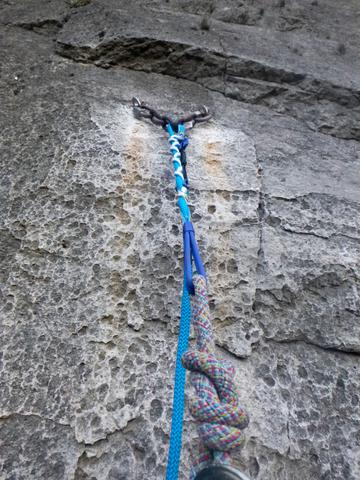
Safely returned to Terra Firma, I let out the massive breath I’d been holding before and gave the rope twelve stout pulls before it came free. And I never used the Beal Escaper again.
Yes, the Escaper works, but using it is simply too mentally taxing and riddled with uncertainty. Call me old fashioned, but I would much prefer to carry a pair of half ropes, or in the instance of the loss of one of these, perform shorter rappels and leave gear.
For me, there are too many variables which might affect the efficiency of the product. What about traversing rappels? What about bulges, cracks, vegetation or other impediments to rope pull? What if the anchor points are too wide to facilitate safely threading the friction hitch? What if the rope happens to become unweighted several times during the course of the abseil? No thanks. I’ll take a European Death Knot any day of the week.
My consternation regarding the product would seem to be shared by many, but I feel as though this has been compounded exponentially by misunderstanding and disinformation. Among the many furphies floating around are that the Escaper isn’t rated (it certainly is, having acquired both UIAA and CE certification) and that the application of the product is limited to rescue purposes (I challenge you to find a SAR team who would put the Escaper into service).
In reality, Beal has been rather coy in suggesting possible deployment of the Escaper. The instruction manual cites “sport and professional uses” and the official website does little to improve the clarity or specificity of this description. It does list “multi-pitch routes, escape, ridge hike, freeride, ski-mountaineering [and] canyoneering” as possible contextual uses. I can certainly see there being an argument for its application in fast-and-light missions, particularly in relation to ski-mountaineering and as an emergency device for high-level alpinism.
What this all amounts to is something like “Choose your own adventure”, or from Beal’s perspective, “If you build it, they will come”. In all likelihood, the Escaper will prove revolutionary for a few but a mere gimmick for most. That said, I sincerely applaud Beal for the innovation behind this product. It’s great to see climbing companies pushing the envelope with new gear which has the potential to revolutionise our sport, just as sticky rubber, spring loaded camming devices and nylon ropes did.
I am certain that some climbers will find use for the Beal Escaper. I am equally certain that they will have much bigger cojones than yours truly.
Ryan Siacci, Esq.

